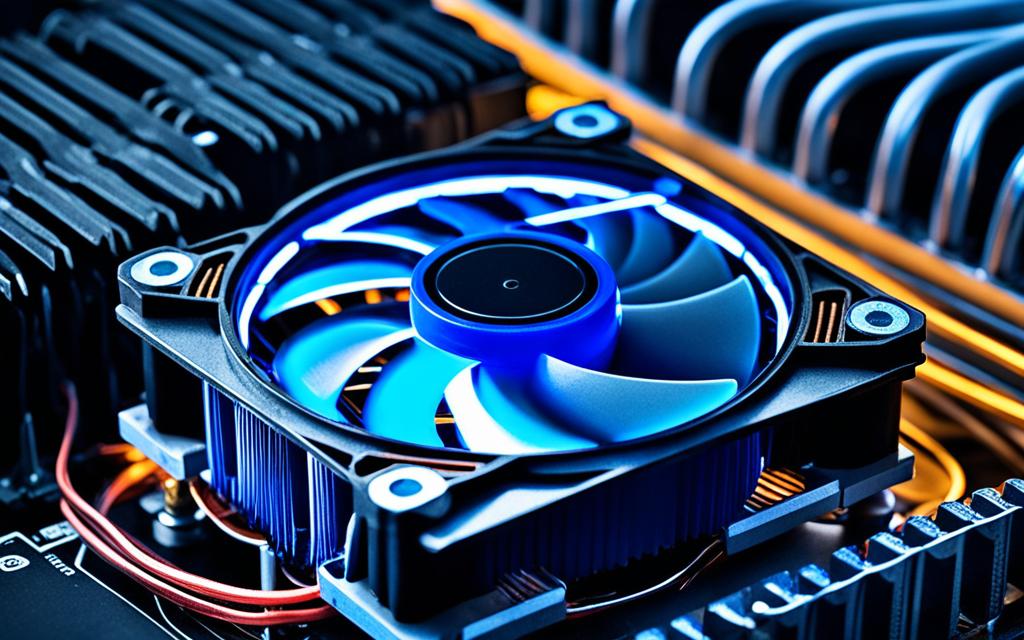Table of Contents
The central processing unit (CPU) is your computer’s heart, handling important tasks to keep things running smoothly. But keeping the CPU cool is key as too much heat can slow it down, damage parts, and shorten its life. Modern CPUs like Intel’s 14th Generation and AMD’s Ryzen 7000 series work best between 90 and 100 degrees Celsius. Yet, older CPUs do better under 85 degrees Celsius1. So, knowing how to cool your CPU is essential for top performance.
In this guide, we’ll explore various CPU cooling tips. We’ll cover how to clean your system properly, upgrade your cooling setups, and tweak system settings. These steps can lead to lower temperatures. This, in turn, boosts your computer’s lifespan and its efficiency.
Key Takeaways
- Understanding the temperature limits of modern and older CPUs can aid in monitoring performance.
- Regular cleaning and dust management are essential to maintain optimal airflow and cooling efficiency.
- Choosing appropriate cooling solutions, such as air or liquid cooling, can significantly impact temperature control.
- Adjusting system settings, like undervolting, can help mitigate overheating without sacrificing performance.
- Incorporating better airflow strategies maximises the effectiveness of your existing cooling solutions.
Understanding CPU Temperature Limits
Knowing the right CPU temperature range is key for good performance. CPUs should work between 30°C to 40°C (86°F to 104°F) when not doing much. When busy, they can get as hot as 60°C to 70°C (140°F to 158°F)2. CPUs can be okay up to 80°C (176°F), but going higher might slow them down to prevent damage2.
If the temperature often goes above 80°C, it could harm the CPU’s performance and life3.
What Constitutes a High Temperature?
Temperatures over 80 degrees Celsius are seen as high for CPUs. It’s best if the CPU doesn’t go over 90°C (194°F) during heavy use for safety2. Older CPUs, like some Intel i5 and i7 models, might handle more heat. This depends on their design and cooling system3.
It’s crucial to use tools like HWMonitor or Core Temp to watch your CPU’s temperature. This way, you can take steps to prevent it from getting too hot. Managing CPU temperatures well is important.
How to Reduce CPU Temp: Cleaning and Maintenance
Keeping your CPU cool is key for the best performance and a long life. One big cause of heat is dust build-up in your PC. By doing regular cleaning and following good CPU dust prevention techniques, you can really help your system stay cool.
Importance of Dust Management
Dust is like a blanket that stops cooling by blocking airflow and covering heatsinks. Cleaning regularly with compressed air or a vacuum cleaner is a great tip. It can significantly lower your CPU’s temperature. This makes managing dust vital for every computer owner4. You should also change thermal paste every three years to keep cooling efficient. Buying good cleaning tools, like the HIDENEL Compressed Air Duster Can for about $27, is a wise investment5.
Optimising Airflow within Your Case
Getting the airflow right inside your case is crucial for managing CPU temperatures. Placing intake and exhaust fans smartly can really boost air circulation. Also, keeping cables tidy helps air move better. This helps cool your CPU and keeps your system working well, especially under heavy use4.
A table below shows how good airflow and cleaning can impact your CPU’s temperature.
| Practice | Impact on CPU Temp |
|---|---|
| Regular Dust Cleaning | Significant decrease in temperature |
| Replacing Thermal Paste | Improves cooling performance |
| Optimal Fan Configuration | Enhances air circulation |
| Removing Obstructions | Lower overall CPU temperature |
Using smart dust management and airflow tricks makes for a better computer. It leads to cooler parts, meaning they last longer and work better. Keeping your system cool is about doing little things regularly. The effort is totally worth it for a high-performing computer4.
Upgrading Cooling Solutions
Keeping your CPU at the right temperature is key. Upgrading cooling solutions is often needed when old methods aren’t enough. There are two main types: air cooling and liquid cooling. Each has its own benefits, making the choice important for your computer.
Choosing Between Air and Liquid Cooling
Air cooling uses heatsinks and fans to remove heat. It’s good for regular use. But, if you’re really pushing your system, liquid cooling is better. It helps CPUs perform at their best, quietly. Upgrading the CPU cooler can make your PC quieter and more efficient, even under heavy use6. Remember, modern chips should not get hotter than 90 to 100 degrees Celsius1.
Benefits of a Custom Cooling System
Custom cooling solutions let you make a system that’s just right for you. They can look great and work efficiently. Having many fans helps keep things cool7.
Water cooling is especially good at lowering CPU temps. It can use big radiators or several cooling loops. Custom systems can offer quiet operation and stop things from getting too hot. This lets you get the most from your system without overheating6.
| Cooling Type | Pros | Cons |
|---|---|---|
| Air Cooling | Cost-effective, easy to install | Noisier, less efficient for overclocking |
| Liquid Cooling | Superior heat management, quieter | Higher cost, complexity in setup |
| Custom Solutions | Complete control over performance, aesthetic appeal | Time-consuming to build, requires maintenance |
Choosing the right cooling solution is vital. It helps your system stay at peak performance and avoids overheating.
Adjusting System Settings for Better Temperature Control
Adjusting system settings can make your CPU cooler. Using less energy helps lower temperatures and boosts overall performance. By lowering the voltage with undervolting, heat decreases without affecting speed.
Undervolting Your CPU
Undervolting your CPU reduces its heat. You can use overclocking software for Intel and AMD to cut voltage. This keeps your parts working longer and avoids overheating issues like sudden shutdowns8. Keep an eye on temperatures, staying below 80-85 degrees Celsius (176-185 degrees Fahrenheit) is safe9.
Power Settings and Performance Management
Changing power settings helps manage CPU heat. Set your processor’s max state to 80-90 percent in Windows to cool it down without losing speed8. Keeping cables tidy and the inside clean improves airflow8. Checking temperatures when idle and under load shows if cooling is working well9.
| Parameter | Recommended Setting | Effects |
|---|---|---|
| Maximum Processor State | 80-90% | Reduces CPU heat generation |
| CPU Voltage | Undervolted | Lowers temperature while maintaining performance |
| Cleaning Frequency | Every few months | Prevents dust buildup |
| Thermal Paste Application | Reapply as needed | Ensures efficient heat dissipation |
Adjusting these settings can lead to better CPU temperatures. It boosts efficiency and performance stability.
Adopting these steps will improve your computer’s performance and hardware lifespan.
Conclusion
Managing CPU temperature well is vital for keeping your computer running longer and better. By following cooling advice like cleaning often, getting better coolers, and tweaking your settings, you can avoid overheating. Dust can block air from moving freely, so it’s important to clean regularly to keep things running smoothly10.
Choosing high-quality coolers can make a big difference in managing heat11. Also, using fan controls in your BIOS lets you adjust fan speeds based on how much work your computer is doing12. These steps not only make your computer more responsive but also more dependable when you’re pushing it hard.
At the end of the beer
day, paying attention to your computer’s cooling needs matters a lot. By doing so, you ensure a great performance for now and future. This way, you keep your CPU in top shape101112.
FAQ
What are the normal temperature ranges for modern CPUs?
Modern CPUs like Intel’s 14th Gen and AMD’s Ryzen 7000 series usually work between 90-100 degrees Celsius. Older ones are safe up to 85 degrees Celsius.
How can I tell if my CPU is overheating?
When CPU readings consistently go over 80 degrees Celsius, that’s high. Near 90-100 degrees, performance might drop to avoid harm.
What methods can I use to clean my PC and reduce dust accumulation?
Use compressed air or a vacuum for cleaning. Keeping dust filters clean and ensuring free airflow inside your PC is crucial.
Is it better to upgrade to air or liquid cooling?
Liquid cooling beats air cooling in heat removal and runs quieter. Yet, consider its higher cost and complexity before deciding.
What does undervolting mean and how does it help?
Undervolting cuts the CPU’s voltage to reduce heat while keeping performance the same. It improves energy use and manages temperatures better.
How can I optimise my system settings for better CPU temperature control?
You can lower CPU temperatures by adjusting your power settings. Enable power-saving modes or pick a balanced power plan to lighten the CPU’s load.
Source Links
- https://www.xda-developers.com/how-to-lower-cpu-temperature/ – How to lower your CPU’s temperature
- https://www.noyafa.com/blogs/knowledge-base/good-cpu-temperature – What Is A Good CPU Temperature? A Guide to Keep Your Processor Cool
- https://community.spiceworks.com/t/what-is-a-normal-temperature-for-a-cpu-and-how-do-i-keep-it-low/948818 – What is a normal temperature for a CPU and how do I keep it low?
- https://www.pandasecurity.com/en/mediacenter/how-to-check-cpu-temp/ – How to Check Your CPU Temperature – Panda Security
- https://www.xda-developers.com/how-to-lower-cpu-temperature-laptop/ – 6 effective ways to lower your laptop’s CPU temperatures
- https://www.digitaltrends.com/computing/how-to-improve-pc-cooling/ – How to improve PC cooling — make your PC run cooler and quieter | Digital Trends
- https://www.lifewire.com/ways-to-keep-your-computer-cool-2624713 – 11 Ways to Keep Your Computer Cool
- https://dotesports.com/general/news/how-to-lower-cpu-temperature – How to lower CPU temperature | Reducing CPU temp
- https://www.jawa.gg/blog/how-to-lower-cpu-temperature/ – How to Lower CPU Temperature
- https://www.electronicshub.org/how-to-lower-cpu-temp/ – How to Lower CPU Temp?
- https://pcmechanicfl.com/pc-repair/lowering-cpu-temperatures-a-guide-to-cool-and-efficient-computing/ – Lowering CPU Temperatures: A Guide to Cool and Efficient Computing – PCMechanic Computer Repair Davenport, FL
- https://www.pcguide.com/cpu/how-to/lower-temperature/ – Here’s how to lower CPU temperature using 8 methods








